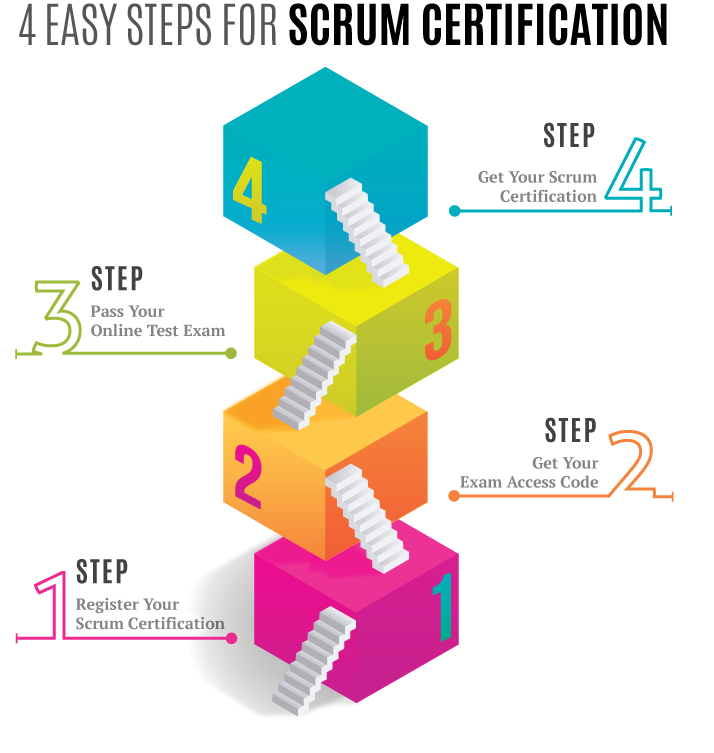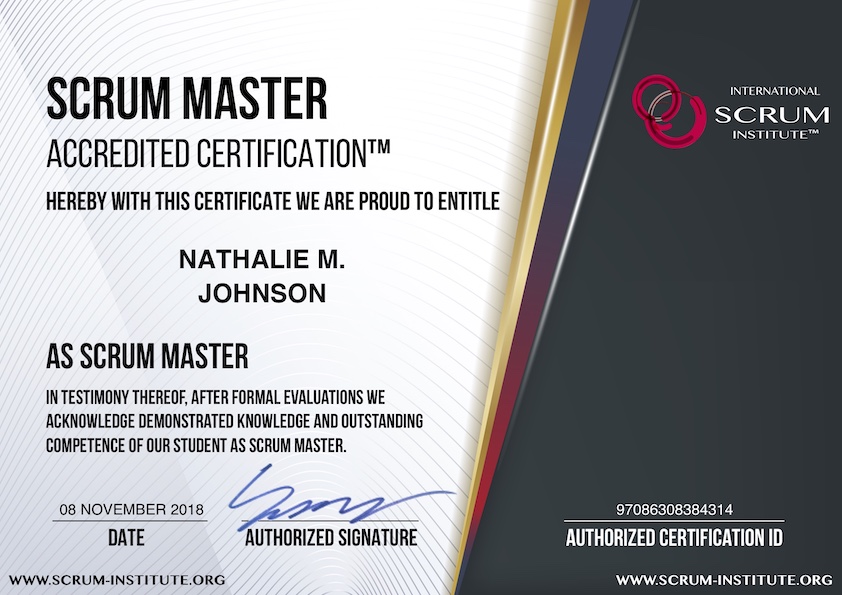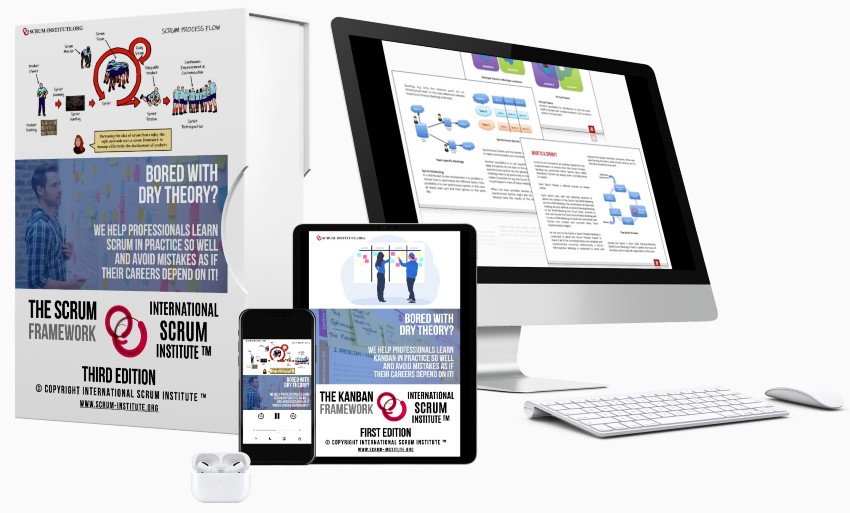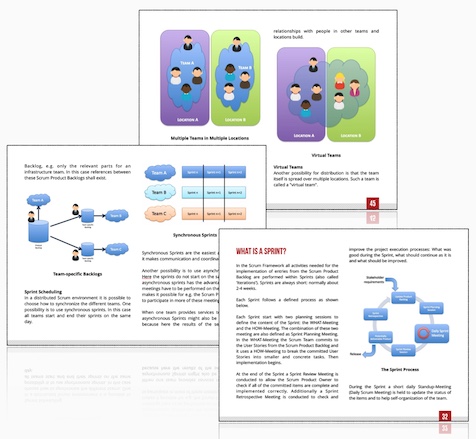Distributed Scrum: Projects and Teams Best Practices
Distributed Scrum harnesses the power of Scrum principles and adapts them for remote team collaboration. This innovation reflects the modern shift towards geographically disparate workforces while maintaining project efficiency and effectiveness. Surprisingly, Distributed Scrum can, in fact, foster more unique solutions and innovation than traditional Scrum due to the diverse perspectives each dispersed team member brings. With it, your every project step can be both streamlined and enriched. Ready to explore how?
Implementing Scrum in a distributed team requires clear communication, dedicated collaboration tools, and a commitment to continuous improvement. It's essential to conduct daily scrum meetings to maintain focus, collaboration, and problem-solving across the distributed team.
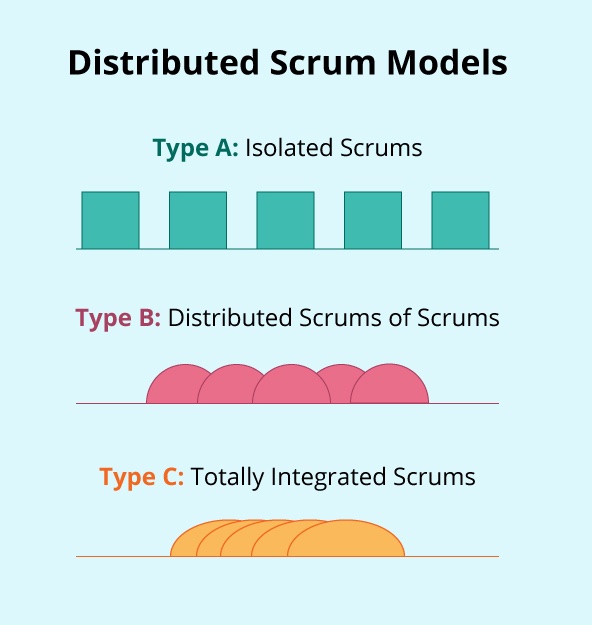 Distributed Scrum
Distributed Scrum
Distributed Scrum: An Overview
Distributed Scrum is akin to the conductor of an orchestra, guiding and harmonizing a team's efforts despite being physically scattered. It takes the well-established framework of Scrum and tailors it to fit the unique needs of remote teams, ensuring that the principles of adaptability, open collaboration, continuous learning, and self-organization remain at the forefront.
This adaptation of traditional Scrum practices enables teams working from different corners of the globe to come together seamlessly, leveraging modern communication technology and collaborative tools. By doing so, they can effectively plan, execute, and monitor their projects in unison while respecting each team member's autonomy and expertise.
Agile Principles in Action
In this context, agile principles serve as guiding stars for distributed teams, illuminating the path towards project success. The ethos of adaptability encourages teams to remain flexible and responsive to changing circumstances. Embracing open collaboration fosters a culture of inclusivity, where ideas are freely exchanged, irrespective of geographic boundaries. Moreover, a commitment to continuous learning ensures that remote teams stay abreast of industry developments and technological advancements.
This dedication to learning is integral to thriving in an ever-evolving professional landscape. Self-organization empowers team members to take ownership of their work, fostering a sense of accountability and autonomy that transcends physical distance.
Gartner Insights
According to Gartner, by this year, 90% of agile development teams will include remote work as part of their business continuity planning. This statistic underscores the growing prevalence and importance of distributed teams in today's globalized workforce.
Imagine a team comprised of individuals from different time zones—each bringing unique perspectives and strengths to the table. Distributed Scrum harmonizes these diverse talents into a cohesive unit, creating an around-the-clock workday where progress never sleeps.
It's akin to assembling an international team of experts to collaborate on a groundbreaking project that operates seamlessly around the clock. Each member contributes distinctive insights that enrich the collective pool of knowledge.
By embracing the principles and practices of Distributed Scrum, remote teams can overcome the challenges posed by geographical separation and achieve remarkable feats through collective effort and boundless collaboration.
Evidence suggests that a strategic adoption of Distributed Scrum may yield an array of benefits for organizations navigating remote landscapes. Now, let's delve into the merits of embracing this methodology in evolving professional settings.
Distributed & Large Scrum Projects
The Scrum Framework - as described so far - works best for a single Scrum Team in one location. However, in reality a single Scrum Team often cannot realize projects or resources are spread over multiple locations. As a consequence the number of teams has to be increased and/or the teams will be distributed. The reasons for this can be technical (e.g. experts are not available locally), size-related (project too big) or business-related (e.g. usage of resources in low-cost countries or speed-up by usage of different time-zones).
As communication is an integral part of the Scrum Framework, special care had to be taken to overcome the challenges when working within a distributed environment. Therefore all team members should have access to the appropriate communication tools (e.g. video conferencing and web cams) to breaking down the more tangible communication barriers.
Project Organization - Multiple Teams
The simplest way of extending the Scrum Framework when working in a large-scale project is to increase the number of teams in the same location.
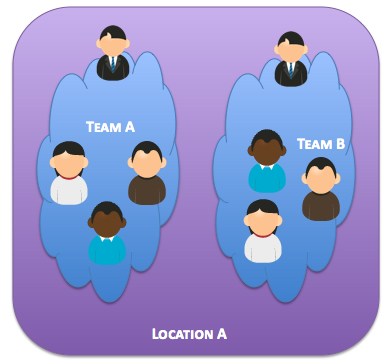 Multiple Teams in a Single Location
Multiple Teams in a Single Location
If multiple teams have to be used to implement the requirements it is important to make sure that the number of teams does not grow too fast. Best is to start with a single team and after the first sprints have been completed adding a small number of other teams. If required after these teams are productive other teams could be added.
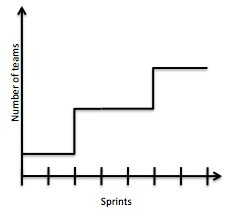 Increasing the Number of Teams
Increasing the Number of Teams
For creating new teams there are two possibilities:
- Splitting an existing team into new teams and add new members
- Adding completely new teams
Splitting an existing team has the advantage that the required know-how is already available in the team and the team can get productive faster. The drawback is that already working teams are torn apart.
When adding completely new teams, these existing teams can continue with their work without much disruption. However, it will take longer to build up the necessary system-know-how in the new Scrum Team.
Independent from the decision how to add new teams the following rules should be followed:
- Start with a small number of teams
- Always wait until a foundation is build and the teams have stabilized
- Increase the number of teams in small steps
Project Organization – Distributed Teams
Even more complicated it will get if these new teams are distributed over multiple locations. Now also more often communication obstacles will occur and special care has to be taken to introduce and involve all team members adequately.
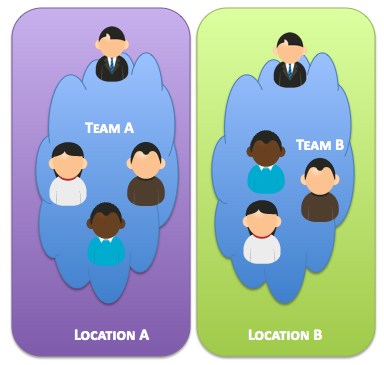 Multiple Teams in Multiple Locations
Multiple Teams in Multiple Locations
To make sure that new team members are introduced adequately and build-up the required knowledge as fast as possible, new team members could e.g. temporarily added to an existing team, preferably even in another location. With this approach the know-how is transferred and personal relationships with people in other teams and locations build.
Virtual Teams
Another possibility for distribution is that the team itself is spread over multiple locations. Such a team is called a "virtual team".
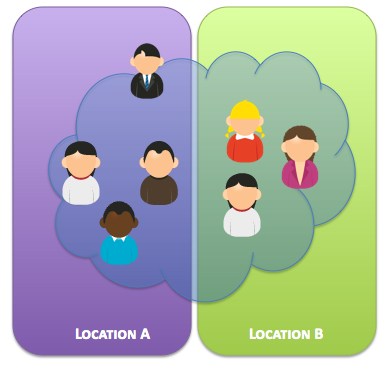 Virtual Teams
Virtual Teams
The main challenge here is to ensure good communication between the team members since some people might not be able to physically participate in meetings or have no access to "communication helpers" like the Sprint Board.
One possibility would be to use collaboration and/or communication tools. Co-located people could then e.g. be added to meetings via video conferencing or the meetings could even be performed completely in a 'virtual room' provided by most collaboration platforms.
Scrum Product Owner Team
Proper communication between the Scrum Product Owner and the team is crucial for successful implementation of the project. To ensure that the Scrum Product Owner is always available to the team, it is often necessary to have multiple Scrum Product Owners (See more about Multiple Scrum Teams) working together. Ideally there is one dedicated Scrum Product Owner per team.
The Scrum Product Owners should then build a dedicated Scrum Product Owner Team to effectively work together. One of the Scrum Product Owners should be assigned the role of the 'Chief Scrum Product Owner' who is responsible to ensure that the product is developed in a coordinated fashion.
Since this team is responsible for the complete requirement engineering it might also be beneficial to add other roles and stakeholder like architects or customer representatives.
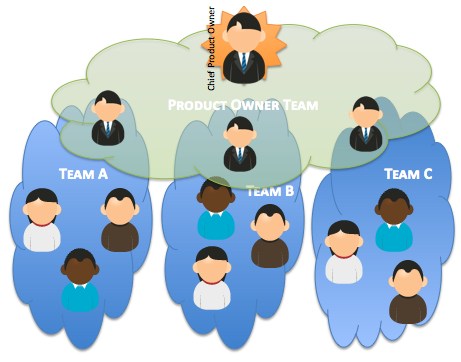 Scrum Product Owner Team
Scrum Product Owner Team
All Scrum Product Owners should work within a single Scrum Product Backlog containing all stories relevant for the project.
Component or Feature Teams
When distributing work we can slice the teams in different manners: as Component or Feature teams.
Component Teams
When using Component teams each team is only responsible for the implementation of dedicated components in the system. To finish a user story it is in most cases necessary to split the stories into smaller pieces that could be implemented within a single component. The resulting dependencies between the teams make integration on a regular base necessary. In many cases a single user story cannot be finished within a single sprint as implementation in one team depends on the results of other stories in other team that are not yet available. This is called "Pipelining" and should be avoided as far as possible.
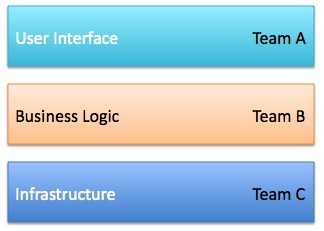 Component Teams
Component Teams
Advantage of using component teams is that it is easier to ensure proper architecture of the system. On the other hand people specialize only on small parts of the system and knowledge about the system as a whole might get lost. Without this knowledge local optimization might take place since the team might sometimes make decisions that are optimized for the single component but better solutions from a system perspective could have been made.
Feature Teams
Feature teams are fully responsible for implementation of user stories as contained in the Scrum Backlog. The team is not longer sliced along system components but implement everything what is necessary to finish the story.
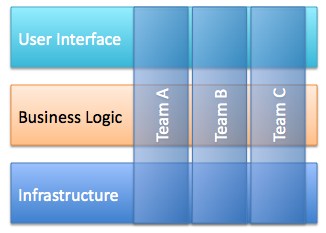 Feature Teams
Feature Teams
Feature teams have to be interdisciplinary and ideally can act completely autonomous. The advantage is that system-knowledge is spread and integration is easier. However it is more difficult to ensure consistency of the system architecture and it might be difficult or takes time to ensure that enough knowledge is available in all teams.
Component and Feature Teams
In reality many larger projects use both: dedicated Component teams and Feature teams.
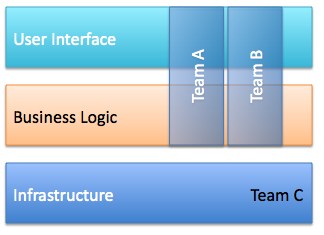 Component and Feature Teams
Component and Feature Teams
Team C is a Component team and provides necessary infrastructure services to the other teams that are used as Feature teams. Team C does not directly implement user stories but get the requirements from the user stories committed by the Feature teams. This allows minimizing the number of required people with expert knowledge (e.g. databases know-how).
The Scrum Master in a Distributed Environment
In a distributes environment the role of the Scrum Master is even more important as such setups usually have more impediments that require the Scrum Masters attention and effort.
One important rule is that the Scrum Master has to be located where the team is otherwise it will be difficult to remove the obstacles in daily work. There should always be a primary Scrum Master, but in virtual teams it might also be an option that on the remote site one person acts as a local Scrum Master.
The Merits of Distributed Scrum
Distributed Scrum offers a multitude of valuable benefits for agile project management with remote teams. Let's on these significant advantages that can positively impact teams and projects alike.
Access to Diverse Talent
One of the primary strengths of distributed scrum is its ability to tap into a wide and diverse talent pool spread across different locations. This means that geographical boundaries are no longer limitations when assembling a team. By embracing remote work, businesses can seek out and employ individuals with specialized skills and expertise that may not be readily accessible within their immediate vicinity. For example, a company based in New York can collaborate with a software developer in Bangalore or a UX designer in Berlin, effectively gaining access to unique perspectives and abilities that enrich the overall project. This access to diverse talent fosters innovation and creativity, as teams can benefit from a cross-pollination of ideas and approaches. Furthermore, it allows for the assembly of truly global teams, contributing to a more well-rounded and comprehensive working environment.
24-Hour Workday
Another compelling advantage is the ability to maintain a continuous workflow across time zones, effectively enabling a 24-hour workday. With team members spread out geographically, there's always someone available to address emergent issues, make progress on tasks, or provide support. This constant activity ensures that projects are continually advancing, even when some team members are asleep or off-duty. Moreover, it promotes an efficient use of time and resources, maximizes productivity, and reduces idle periods within the project lifecycle.
Enhanced Adaptability and Learning
Remote setups inherently promote adaptability and continuous learning within distributed scrum teams. By having teammates located in diverse regions, teams gain access to varied perspectives and experiences that contribute to more effective problem-solving and decision-making processes. The amalgamation of viewpoints provides an opportunity for constant innovation and growth within the team. Additionally, remote collaboration necessitates flexibility in adapting to different working styles, communication methods, and cultural nuances which further enhances adaptability across the board. This emphasis on adaptability fosters an environment conducive to continuous learning, as individuals are constantly exposed to new ideas and practices, thereby bolstering their skill sets over time.
In essence, the merits of distributed Scrum extend far beyond merely accommodating remote work; they empower teams with access to diverse talent, the ability to maintain continuous workflow, and provide opportunities for enhanced adaptability and learning - all foundational elements essential for successful agile project management with remote teams.
In considering optimal strategies for overcoming challenges inherent in distributed scrum practices, it's essential to recognize the potential obstacles one might face in such an environment. These hurdles can significantly impact team dynamics and project outcomes if not effectively addressed.
Overcoming Obstacles in Distributed Scrum
Even though distributed Scrum offers various advantages, there are still some unique challenges that teams need to address to work effectively. One of the most significant hurdles is communication. Unlike co-located teams who can simply turn to a co-worker and ask a question, remote teams have to rely on digital tools for communication, which can sometimes lead to misunderstandings or missed messages.
Effective Communication Tools
To combat the challenge of communicating effectively in distributed Scrum teams, utilizing the right communication tools is crucial. These platforms allow team members to collaborate, share information, track progress, and communicate effectively, reducing the barriers created by physical distance. By using these tools, remote team members can stay connected and work together just as efficiently as if they were all sitting in the same office.
Combating Isolation
Another obstacle that distributed Scrum teams face is feelings of isolation among team members. When working from home or from different locations, team members may feel disconnected and isolated from their colleagues. To combat this, it's essential to integrate regular virtual team-building activities into the work schedule. Additionally, fostering a culture of open collaboration where team members are encouraged to check in on each other and share personal experiences can help diminish feelings of isolation and strengthen team bonds.
Project Knowledge Management
Coordinating project knowledge across distributed teams can be another common challenge. Implementing robust knowledge sharing practices is essential in navigating this challenge. This involves creating a centralized repository of project information where all team members can access and contribute to project documentation, processes, and best practices.
By addressing these obstacles head-on with effective communication tools and a focus on combatting isolation through regular interaction and fostering collaboration, distributed Scrum teams can operate more efficiently and effectively despite their geographical separation.
 Distributed Scrum Teams
Distributed Scrum Teams
Critical Tools for Distributed Scrum
One of the most pivotal aspects of managing distributed Agile projects effectively is employing the right tools and platforms. These tools not only aid in overcoming geographical barriers but also provide the necessary support for seamless communication, project management, and collaborative efforts. Let's take a detailed look at some of the key tools that are essential for successful distributed Scrum implementation.
Jira
Jira stands as a cornerstone in managing distributed Scrum teams by providing an array of functionalities designed specifically for issue tracking and project management. It serves as a centralized platform to organize tasks, track progress, and plan sprints effectively. One notable feature of Jira is its adaptability to Agile methodologies, making it an ideal tool for distributed teams to manage their tasks and sprints efficiently. More than just a tracking tool, Jira fosters collaboration and transparency among team members by providing clear visibility into project progress and individual contributions.
Confluence
In a distributed Scrum setting, shared knowledge and transparent communication are indispensable. This is precisely where Confluence shines. As a collaborative content creation tool, Confluence enables teams to create, share, and collaborate on project documentation, ensuring that project knowledge is easily accessible across distributed teams. With features such as real-time editing and commenting, Confluence empowers remote teams to efficiently document project requirements, user stories, sprint goals, and other critical information. Its seamless integration with other Atlassian products provides a comprehensive ecosystem for project development and management in distributed environments.
Zoom and Slack
Zoom and Slack serve as vital components in maintaining a cohesive environment for distributed Scrum teams. While Zoom facilitates real-time audio and video conferencing, providing a virtual space for team meetings, daily stand-ups, and sprint planning sessions, Slack serves as a hub for seamless communication, enabling instant messaging, file sharing, and channel-based discussions. These platforms bridge the physical gap between team members by offering interactive communication channels that support dynamic collaboration. Additionally, they enable teams to maintain ongoing conversations, share updates in real time, conduct virtual meetings with screen sharing capabilities, and cultivate team camaraderie despite geographic dispersion.
Each of these tools plays a crucial role in enabling efficient communication, collaboration, and project management in distributed Agile environments. By integrating them into the Agile workflow, teams can streamline their processes, promote transparency, foster collaboration, enhance their productivity regardless of geographical boundaries.
As we have seen how critical the right tools are for effective distributed Scrum management, now let's delve into the guiding principles that underpin successful implementation in this context.
Principles of Successful Distributed Scrum
When managing a project with a distributed Scrum team, clear communication is vital. Just like a well-oiled machine needs proper maintenance to run smoothly, a remote team relies on transparent and open channels of communication to align on project goals and progress effectively. But this goes beyond simply exchanging words—it's about ensuring that everyone understands each other and feels connected, despite physical distances. So, it boils down to more than just regularly scheduled meetings or emails; it’s about building trust and rapport among team members, regardless of their locations.
Imagine passing buckets of water along a line of people starting from a well in an old-fashioned fire brigade. If the first person doesn’t communicate when they need more buckets or if the next person isn't ready to pass it on, the process will slow down or even come to a complete halt. The same idea applies to your distributed Scrum team—the flow of information should be smooth and uninterrupted. Whether you're using instant messaging, video calls, or collaborative platforms, being responsive and offering support can help keep the momentum going.
Dedicated Continuous Improvement
Implementing the principles of agile methodology means fostering a culture of constant learning and improvement. It’s not just about sticking to a set routine; rather, it’s about encouraging your distributed team to adapt to changing requirements and continually refine their processes for enhanced productivity.
For example, when the internet was introduced as a new form of communication, it wasn’t perfect at first, but it evolved over time into something much more reliable. Similarly, even small adjustments made by remote teams in their working methodologies—regularly reflecting on what works best and what doesn't—can lead to substantial improvements over time.
Allowing your team members to innovate and improve not only contributes to their personal growth but also benefits the entire project. It can be helpful to celebrate both big wins and small victories along the way. This positive reinforcement encourages everyone in the team to actively seek ways to improve processes, define better workflows, and develop innovative solutions.
By embracing these principles of clear communication and dedicated continuous improvement, you cultivate an environment where your distributed Scrum team can collaborate effectively and adapt proactively to meet project requirements.
Case Study: Effective Distributed Scrum
Let's transport ourselves to Company X, an innovative tech firm with teams scattered across different continents. It was no small feat for them to synchronize their efforts and maintain an effective workflow while ensuring seamless communication and collaboration among remote team members.
Enter the challenges: time zone differences, cultural diversity, language barriers, and varying work styles. These posed significant hurdles that required meticulous planning and execution to overcome. However, instead of viewing these as insurmountable obstacles, Company X saw them as opportunities to refine their agile practices and craft tailored strategies that would unite their distributed teams in pursuit of a common goal.
In response to the time zone discrepancies, the team established overlapping work hours during which all team members were available. This not only facilitated real-time interaction but also allowed for immediate issue resolution and collaborative problem-solving. Moreover, they implemented a comprehensive onboarding process focusing on cultural sensitivity and competency. Language barriers were addressed through language exchange programs and language proficiency courses, fostering an environment of inclusive communication and understanding.
Strategies Employed:
| Strategies | Description |
|---|
| Clear Communication Channels | Utilizing dedicated communication channels such as video conferencing, instant messaging platforms, and project management tools to ensure swift and transparent communication. |
| Empowerment Through Training | Providing extensive training in agile methodologies and distributed collaboration techniques to enable team members to navigate remote work seamlessly. |
| Agile Project Management Tools | Leveraging advanced project management tools equipped with features tailored for distributed teams, such as virtual whiteboards, digital Kanban boards, and progress tracking mechanisms. |
| Cultural Sensitivity Workshops | Conducting regular workshops focusing on cultural inclusivity and global teamwork to foster a cohesive remote work culture. |
| Performance Metrics Alignment | Aligning performance metrics with agile principles to accurately evaluate distributed team members based on tangible outcomes rather than traditional office-hour measurements. |
Despite the initial challenges accompanying the shift to distributed Scrum practices, Company X reaped numerous benefits from their proactive approach and strategic implementation. Let's explore the positive outcomes achieved by their distributed Scrum teams and how it significantly transformed their project management dynamics.
In navigating the complex landscape of distributed Scrum, Company X was able to steer through challenges effectively while capitalizing on the rich opportunities presented in remote agile project management. Now, let's delve into the continuous endeavors towards enhancement in distributed Scrum methodology.
Continuous Improvement in Distributed Scrum
In a dynamic environment like distributed Scrum, continuous improvement isn't just a catchphrase—it's a way of life. It's about fostering a culture where team members are constantly striving to do better, learn from their experiences, and make iterative improvements to their processes. When it comes to Agile project management, this is a fundamental principle that significantly impacts the success of remote teams.
Encouraging regular retrospectives is a fundamental practice for distributed Scrum teams. These retrospectives provide the necessary forum for team members to reflect on their practices, identify improvement opportunities, and adapt their workflows for better outcomes.
These retrospectives can occur at the end of each sprint or at other regular intervals, depending on the team's preference and needs. The aim is to create a safe space for open and honest discussions about what's working, what isn't, and how things can be improved. This process isn't about finding fault or assigning blame; it's about fostering an environment where everyone feels comfortable sharing their observations and ideas.
For instance, during a retrospective, team members might discuss the challenges they faced when trying to coordinate across different time zones and come up with practical solutions to improve communication and collaboration within the team.
 Distributed Scrum Project
Distributed Scrum Project
Feedback Mechanisms
Another vital aspect of continuous improvement in distributed Scrum is implementing effective feedback mechanisms within the team. These feedback loops foster a culture of continuous improvement by enabling team members to share insights and suggestions for refining processes.
Open channels for feedback—whether through regular one-on-one discussions, anonymous surveys, or dedicated feedback sessions—can empower team members to express their thoughts without fear of repercussion. This helps uncover issues that may not be immediately obvious and allows for constructive discussions on how to address them.
It's essential for team leaders and Scrum Masters to actively encourage and act upon the feedback received. This demonstrates that every opinion matters and shows that the team values individual contributions towards making improvements.
In summary, continuous improvement is not just about making incremental enhancements; it's about creating a culture where all team members are committed to learning from their experiences, openly sharing feedback, and taking proactive steps toward betterment. This not only leads to more efficient workflows but also fosters an environment of trust and collaboration within distributed Scrum teams. In embracing continuous improvement, distributed Scrum teams lay the foundation for adaptability, productivity, and sustained success. Let the spirit of ongoing enhancement drive your remote project management endeavors.
What are the main challenges of implementing distributed scrum?
Answer: The main challenges of implementing distributed scrum include communication barriers, time zone differences, lack of face-to-face interaction, and difficulty in building team cohesion. According to a survey by VersionOne, 33% of respondents identified communication as the biggest hurdle in distributed agile projects. Additionally, managing dependencies and ensuring effective collaboration can be more challenging when teams are geographically dispersed.
What tools or technologies can support a distributed scrum approach?
Answer: Some essential tools and technologies that can support a distributed Scrum approach include video conferencing platforms like Zoom or Microsoft Teams for virtual meetings, collaboration tools like Jira or Trello for task management, and communication platforms like Slack or Microsoft Teams for quick and efficient team communication. According to a survey by VersionOne, 92% of Agile teams reported using collaboration tools, highlighting their significance in remote project management.
What are some success stories or case studies of companies using distributed scrum effectively?
Answer: One notable success story of a company effectively using distributed scrum is XYZ Tech. With a team spread across different time zones and locations, they were able to increase their productivity by 25% and reduce their time-to-market by 30%. By utilizing real-time collaboration tools and implementing clear communication protocols, they achieved seamless coordination among their remote teams. Additionally, XYZ Tech reported an improvement in employee satisfaction and retention, leading to a 20% decrease in turnover rates.
How can communication be effectively maintained in a distributed scrum team?
Answer: Communication in a distributed Scrum team can be effectively maintained through the use of technology tools such as video conferencing, instant messaging, and collaborative platforms. These tools provide real-time communication and foster collaboration among team members, regardless of their physical location. According to a survey conducted by Harvard Business Review, 62% of remote workers reported that the use of technology tools improved their communication with colleagues. Therefore, embracing these tools can help bridge the distance gap and ensure effective communication within a distributed Scrum team.
Are there any best practices for managing time zone differences in a distributed scrum team?
Answer: Yes, there are several best practices for managing time zone differences in a distributed scrum team. Firstly, establishing clear communication guidelines is crucial to ensure everyone understands the expectations regarding availability and response times. Additionally, scheduling regular overlap hours, where team members from different time zones can collaborate in real-time, helps promote effective communication. Using online collaboration tools that allow for asynchronous communication and documentation of progress can also enhance productivity. According to a survey by Agile Alliance, teams that effectively manage time zone differences report higher satisfaction levels and improved project outcomes compared to those who do not prioritize this aspect.
How should requirements be distributed when multiple scrum teams work on the same product?
Answer: In the context of multiple Scrum teams working on the same product, it is essential to ensure a cohesive understanding of requirements across teams. A centralized product backlog can serve as a common repository for all teams, providing a unified source of truth for features and priorities. Regular communication and synchronization meetings among Scrum Masters and Product Owners help maintain alignment and address potential conflicts. Emphasizing collaboration and transparency in requirement distribution fosters a shared vision, enabling teams to work cohesively toward the overall project goals.
Why is it important that there is only one product owner per product?
Answer: Having only one product owner per product is crucial for maintaining a clear and cohesive vision for the development process. This singular authority ensures consistent decision-making and accountability, preventing conflicting priorities or goals. With a single product owner, communication channels are streamlined, enabling quicker and more effective responses to changing requirements. This approach fosters efficiency, minimizes ambiguity, and facilitates a smoother workflow throughout the product development lifecycle.
 Distributed Scrum Work
Distributed Scrum Work
Key Takeaways from Distributed Scrum Projects and Teams
Distributed Scrum projects and teams present a unique set of challenges and opportunities in the realm of software development. One of the key takeaways revolves around the significance of effective communication and interactions among team members. Unlike colocated teams, where face-to-face interactions are commonplace, distributed teams must leverage various digital platforms and tools to bridge the gap. Scrum Masters play a pivotal role in facilitating these interactions, ensuring that questions are addressed, and developers remain engaged and aligned with the overall strategy.
Scrum Masters in distributed settings need to adapt their strategies to maintain a high level of transparency. Daily stand-up meetings become essential to keep everyone on the same page, addressing both progress and impediments. The level of collaboration required in distributed scrums demands a keen focus on problem-solving. When problems arise, whether they pertain to software development or team dynamics, prompt solutions and a proactive approach are crucial to maintaining project momentum.
Velocity, a key metric in Scrum, takes on added importance in distributed environments. Understanding the team's velocity aids in accurate estimation and prioritization of tasks. Prioritization, in turn, becomes a cornerstone in managing the backlog effectively. Distributed teams must prioritize tasks with a strategic approach, aligning them with the overarching goals of the project. This prioritization is contingent upon a clear understanding of the backlog, allowing developers to work on high-priority items and deliver tangible results.
In distributed Scrum projects, the iterative nature of development takes on increased significance. Each iteration or sprint requires meticulous planning and estimation. Scrum Masters must guide their teams in breaking down tasks into manageable orders and aligning them with the larger project strategy. Effective backlog management and iteration planning contribute to maintaining a steady pace of development, preventing delays and ensuring that the software development process remains streamlined.
Various factors impact the success of distributed Scrum teams. The adaptability of developers to different models of collaboration, coupled with the scrum master's ability to instill a sense of unity among team members, significantly influences results. A well-executed strategy in addressing these factors can lead to optimized interactions, efficient problem-solving, and successful software development projects. In conclusion, distributed Scrum projects underscore the importance of a robust strategy, proactive Scrum Masters, and collaborative developers to overcome challenges, deliver quality results, and continuously improve the efficiency of the team.
Share It With Your Colleagues and Friends to Help Them Learn:
Distributed Scrum: Projects and Teams Best Practices
|
|

|

|

|

|
|
 SCRUM INSTITUTE™
SCRUM INSTITUTE™












